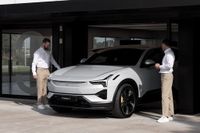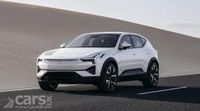Polestar, the electric vehicle manufacturer that emerged from Volvo, has reported a significant sales increase in the first quarter of 2025, selling 12,304 cars globally. This marks a remarkable 76% increase compared to the same period last year, when the company sold just 6,975 vehicles. However, the sales figures are nearly on par with the 12,000 units sold in Q1 2023, indicating that while growth is evident, it has not surpassed previous highs.
The surge in sales can be attributed to the introduction of two new models: the Polestar 3 and Polestar 4. The Polestar 4 joined the lineup in April 2024, while the Polestar 3 began production in the U.S. in August 2024. Despite these additions, the sales numbers suggest that the anticipated boost from the new models has not yet fully materialized.
Michael Lohscheller, CEO of Polestar, expressed optimism about the company’s direction, stating, "We are on the right track and doing the right things. I'm pleased with the progress we are making in transforming our commercial operations." He emphasized the importance of their active selling model and the collaboration with retail partners in achieving these results.
In the U.K., Polestar's performance has been particularly impressive, with 30% of its total sales coming from British customers and a year-on-year growth of 185%. Matt Galvin, Managing Director of Polestar UK, noted that the brand is gaining serious momentum and is becoming a common sight on British roads. He attributed this success to their award-winning lineup of performance EVs and the hard work of their dedicated team.
However, when examining the overall sales trend, it becomes clear that Polestar's recent growth is built on a fragile foundation. The average sales volume for the past two years is approximately 12,212 units per quarter, which is very similar to the current quarter's performance. This raises questions about whether the new models will lead to sustained growth or merely a temporary spike in interest.
Additionally, Polestar faces challenges from geopolitical tensions, particularly the ongoing tariff disputes between the U.S. and China. With two of its three models produced in China, the company is at risk of being adversely affected by these trade barriers. Reports have indicated that tariffs have already impacted other Volvo models, such as the Volvo S90, which has been discontinued for the U.S. market due to these issues.
In response to these challenges, Polestar has ceased taking U.S. orders for the China-made Polestar 2 and is exploring options to increase production capacities in Europe and the United States. The Polestar 3 is already being manufactured in South Carolina, and plans are in place to begin production of the Polestar 4 in South Korea by mid-2025.
Despite the growing sales figures, Polestar's strategy to attract Tesla owners through trade-in incentives of up to $20,000 has raised eyebrows. This approach aims to capitalize on shifting consumer sentiments and capture a segment of Tesla’s customer base, which has been increasingly critical of the brand.
Looking ahead, the company is preparing to launch the Polestar 5 performance four-door model in the second half of 2025, which they hope will further bolster sales. However, the question remains: will this expanded lineup translate into significant gains, or will external factors hinder their progress?
Polestar's recent quarterly results highlight both the potential for growth and the challenges that lie ahead. As the company navigates a rapidly changing automotive landscape, its ability to adapt to market demands and external pressures will be crucial in determining its success in the coming months.
In summary, while Polestar has made strides in increasing its sales and expanding its model lineup, the road ahead is fraught with challenges. The company must contend with economic uncertainties, tariff implications, and competition in the electric vehicle market. As they prepare to release their full financial results for 2024 by the end of April 2025, stakeholders will be keen to see how Polestar plans to address these issues and sustain its growth trajectory.






